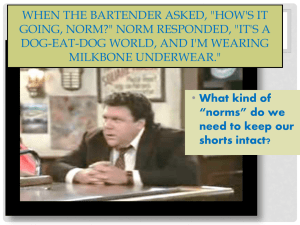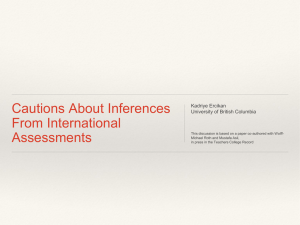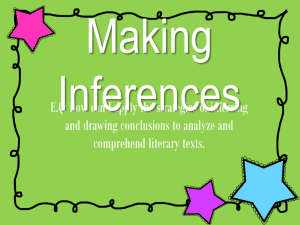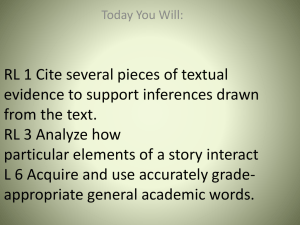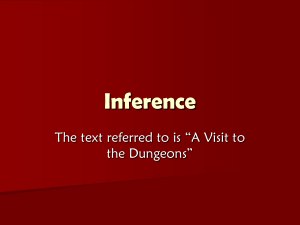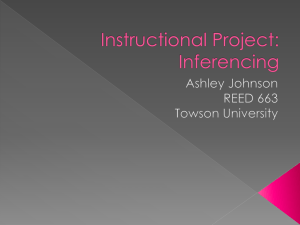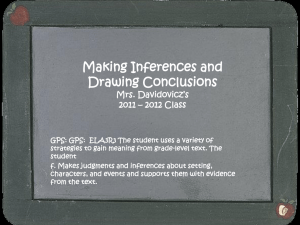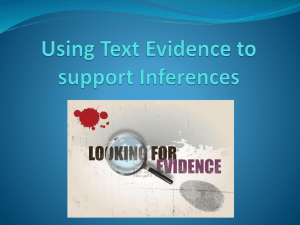Inferences and Drawing Conclusions
advertisement
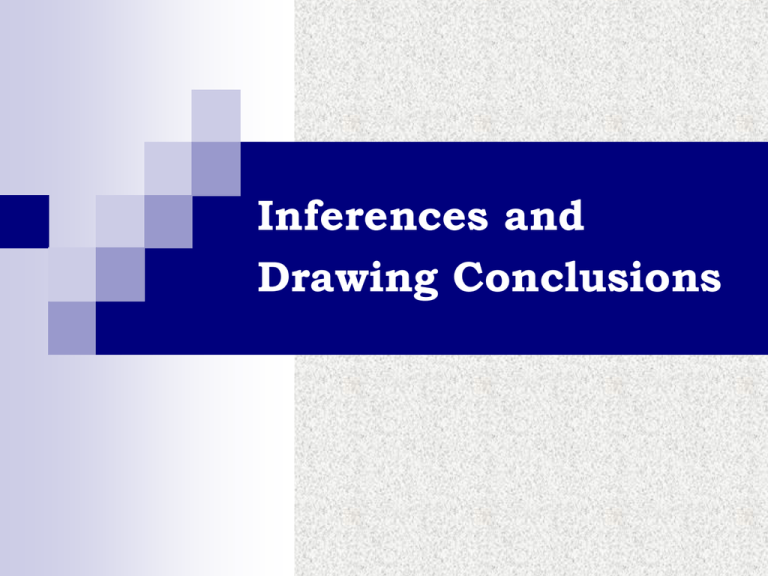
Inferences and Drawing Conclusions Inference Inferences: clues that good readers use to arrive at a conclusion about someone or something “reading between the lines” Prior Knowledge + Textual Evidence = Inference Drawing a conclusion about something that is not in the text The author of a book or an article may not tell you everything that you need to know. You must be able to figure out what he did not say. That means that you must learn how to make good guesses about what the author means. That is called drawing conclusions (Study Island) When you draw conclusions or make inferences you use the information provided by the author along with what you know to fill in gaps. What this usually means is that the author will provide you with most of the information you need, but you might have to make connections of your own to completely understand the story. (Study Island) Practice with Inferences The beautiful insect came out of its cocoon and flew away. Inference: The insect is a butterfly. Once spring arrives, make sure seedlings go in the garden as early as possible. You should cover them if the weather turns cold. Inference: A good inference is that young plants will not grow well if they get too cold. The inference makes sense. Toby is the fastest runner in the school. He even beat Jacob in a race last year. He never walks. He always runs. This year all the boys in third grade will have a race for Field Day. Inference: A good inference is that the writer thinks that Toby will win the race this year. Most of the information in the passage is about how fast Toby can run. Practice with Inferences Jerry sat stiffly on the bench. He hated not being able to help his basketball team in their biggest game of the season. He looked over where two silver crutches leaned against the bench, then looked back out on the floor. "Why did this happen to me?" he wondered. What conclusion can you draw after reading the passage? Inference #1: Jerry is injured. Clue 1: He is sitting on the bench, not playing in the game. Clue 2: There are two crutches leaning against the bench. Clue 3: His questions, "Why did this happen to me?" What can you infer about Jerry's injury? Inference: He injured a leg or a foot. The author mentions two silver crutches, and you know that a crutch is used to help an injured person walk. The author doesn't say what Jerry injured, but if you combine what is said with what you know, you can make an evidence-based guess that Jerry hurt his leg or foot. Practice with Inferences Snowfall is helping firefighters contain fires still burning in California. Freezing temperatures in mountain areas have dampened down the flames that remain. Fires have now been burning California for two weeks. So far, 22 people have died. 3,500 homes have been destroyed. The helpful change in weather means firefighters can take a break to see their families after weeks of being away from home. The fires may be dying down, but the disaster is not over yet. Almost 27,000 people are still living in shelters. They cannot return to their homes yet. Practice with Inferences 1. What can you infer from the passage? A. The firefighters had to work hard to make sure that wildlife in the nearby forests would be safe. B. Without the colder temperatures, firefighters would have had a harder time fighting the fires. C. Now that the fires are contained, there isn't a real threat, and the disaster is finally over. D. Now that it's the rainy season, California will have to deal with future floods and thunderstorms. Practice with Inferences The truck was round and short and rusty. Painted on the side were the words, "Preston's Pest Control." It had a sharp, metal bumper on the back and a large snow plow on the front. There was a hose attached to it that was dripping a bright green liquid. What can you infer from the description of the truck? A. The truck is dangerous for children to play around. B. The truck is so old that it does not run. C. The truck has not been used in years. D. The truck is used only during the winter. Practice with Inferences The clock struck 8:00 PM, and I had just gotten my little brother and sister into bed. I stumbled back down the hallway to the living room, grabbed my backpack, and cleared off the kitchen table. It was finally time for me to start my homework, and I had a lot to do. After my homework, I would fix a plate for my dad and set it in the microwave with heating instructions taped to the door. He would get in long after I had gone to bed, and he appreciated the little things I did to help him. For the last month, this had been my life. My mother had moved to California for six months to film a low-budget movie, leaving my dad to care for three children. At twelve, I became the woman of the house. My dad switched to the night shift at the factory so that he could be home with my brother and sister while I went to school. While he was at work, I took care of my brother and sister, made dinner, and cleaned the house. I actually liked cooking. I experimented with food and created a few masterpieces out of a little pasta, some meat, and leftover vegetables. After eating one of my creations, Dad said he could see me working in a big city restaurant, serving famous people. I smiled at that idea. It would be fun. Practice with Inferences What can the reader conclude about the narrator's mother? A. She does not have a job. B. She is a movie actress. C. She makes a lot of money. D. She hates leaving her family. Which sentence from the story best supports the conclusion that the narrator would like to be a chef someday? A. My mother had moved to California for six months to film a low-budget movie, leaving my dad to care for three children. B. I experimented with food and created a few masterpieces out of a little pasta, some meat, and leftover vegetables. C. I stumbled back down the hallway to the living room, grabbed my backpack, and cleared off the kitchen table. D. My dad switched to the night shift at the factory so that he could be home with my brother and sister while I went to school. Light Bulb Inference Activity There are many kinds of students who attend Conrady Junior High School. Some students are Caucasian, some are Arabic, some are Polish, some are Lithuanian, some are Hispanic, and some are African American. The students range from 11 to 14 years of age. What can you infer from the passage? A. Conrady is the greatest school in the world. B. Conrady is a diverse school. C. All students from Conrady are from a different country. D. Conrady celebrates the nationalities of each student.



